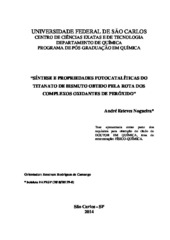| dc.contributor.author | Nogueira, André Esteves | |
| dc.date.accessioned | 2016-06-02T20:34:57Z | |
| dc.date.available | 2014-10-30 | |
| dc.date.available | 2016-06-02T20:34:57Z | |
| dc.date.issued | 2014-08-14 | |
| dc.identifier.citation | NOGUEIRA, André Esteves. Photocatalytic properties of bismuth titanate synthesized by the oxidant peroxide method. 2014. 105 f. Tese (Doutorado em Ciências Exatas e da Terra) - Universidade Federal de São Carlos, São Carlos, 2014. | por |
| dc.identifier.uri | https://repositorio.ufscar.br/handle/ufscar/6321 | |
| dc.description.abstract | The welfare of the population and technological progress of our society largely depend on the development and the intensive use of synthetic materials, generating a large amount of residual chemicals and high energy consumption. Therefore, the need for development of synthesis routes that are more efficient, economic and environmentally sustainable, both for obtaining new materials as well as for improvement of those traditionally used by the productive sector, has grown in importance. Therefore, the study aimed to understand and extend the use of the oxidant peroxide method (OPM), as a new synthesis route for obtaining bismuth titanate with the sillenite (Bi12TiO20) and perovskite (Bi4Ti3O12) phase. In addition, we studied the influence of defects formed in the structure by the introduction of dopants such as niobium, lanthanum, and lead. These changes were made to obtain materials with improved structural and optical properties for use in the photodegradation process of the organic dye rhodamine B (RhB) under ultraviolet and visible radiation. Through obtaining the amorphous precipitate by the OPM route we observed the formation of spheres of bismuth oxide (Bi2O3) with titanium dioxide (TiO2) nanoparticles with surface peroxo groups that were identified as mainly responsible for the high reactivity of the powders obtained by this synthesis method. The photocatalytic properties of all materials were evaluated by the discoloration of RhB solution under UV and visible irradiation, where the bismuth titanate obtained by the OPM route showed higher photocatalytic activity than the commercial TiO2. Obtaining bismuth titanate calcined at different temperatures allowed the understanding of the effects of crystallinity on the photocatalytic activity. Furthermore, it was observed that the insertion of different ions in the bismuth titanate (Bi12TiO20) structure modified the band gap energy in different ways, which consequently altered the photocatalytic activities of the materials, showing the dependence of the redox potential of the conduction and valence band in the photocatalysis process. | eng |
| dc.description.sponsorship | Universidade Federal de Minas Gerais | |
| dc.format | application/pdf | por |
| dc.language | por | por |
| dc.publisher | Universidade Federal de São Carlos | por |
| dc.rights | Acesso Aberto | por |
| dc.subject | Fotocatálise | por |
| dc.subject | Titanato de bismuto | por |
| dc.subject | Síntese | por |
| dc.subject | Rodamina B | por |
| dc.subject | Peroxo-complexo | por |
| dc.title | Síntese e propriedades fotocatalíticas do titanato de bismuto obtido pela rota dos complexos oxidantes de peróxido | por |
| dc.title.alternative | Photocatalytic properties of bismuth titanate synthesized by the oxidant peroxide method | eng |
| dc.type | Tese | por |
| dc.contributor.advisor1 | Camargo, Emerson Rodrigues de | |
| dc.contributor.advisor1Lattes | http://lattes.cnpq.br/7720754304065239 | por |
| dc.description.resumo | O bem estar da população e o progresso tecnológico de nossa sociedade dependem, em grande parte, do desenvolvimento e do intensivo uso de materiais sintéticos, o que gera um grande volume de resíduos químicos e um elevado consumo de energia. Portanto, a necessidade do desenvolvimento de rotas de síntese que sejam mais eficientes, econômicas e ambientalmente sustentáveis, tanto para a obtenção de novos materiais, quanto para o aperfeiçoamento daqueles tradicionalmente utilizados pelo setor produtivo, tem crescido em importância. Desta forma, o trabalho visou compreender e ampliar o uso do método dos complexos oxidantes de peróxido (OPM), como uma nova rota de síntese para a obtenção do titanato de bismuto com a fase selenita (Bi12TiO20) e perovskita (Bi4Ti3O12). Além disso, avaliou-se a influência dos defeitos formados na estrutura dos materiais pela adição de diferentes dopantes como: nióbio, lantânio e chumbo. Essas modificações foram realizadas a fim de obter materiais com melhores propriedades estruturais e ópticas para aplicação no processo de fotodegradação do corante orgânico rodamina B (RhB) sob radiação ultravioleta (UV) e visível. Através da obtenção dos precipitados amorfos pela rota OPM observou-se a formação de esferas de óxido de bismuto (Bi2O3) juntamente com nanopartículas de dióxido de titânio (TiO2) com grupos peroxos superficiais que foram identificados como os grandes responsáveis pela elevada reatividade dos pós obtidos por este método de síntese. As propriedades fotocatalíticas de todos os materiais foram avaliadas através da descoloração da solução de RhB sob irradiação de luz UV e visível, no qual os titanatos de bismuto obtidos pela rota OPM apresentaram atividades fotocatalíticas superiores ao TiO2 comercial. A obtenção do titanato de bismuto tratado termicamente em diferentes temperaturas permitiu o entendimento dos efeitos da cristalinidade sobre a atividade fotocatalítica. Além disso, observou-se que a inserção de diferentes íons na estrutura do titanato de bismuto (Bi12TiO20) alterou de maneiras diferentes a energia do band gap, que consequentemente alterou as atividades fotocatalíticas dos materiais, deixando clara a dependência dos potenciais redoxes da banda de condução e de valência no processo de fotocatálise. | por |
| dc.publisher.country | BR | por |
| dc.publisher.initials | UFSCar | por |
| dc.publisher.program | Programa de Pós-Graduação em Química - PPGQ | por |
| dc.subject.cnpq | CIENCIAS EXATAS E DA TERRA::QUIMICA | por |
| dc.contributor.authorlattes | http://lattes.cnpq.br/9755377874560173 | por |
